Much has been written about one of the world’s greatest kingdoms and the city of Angkor. But I was surprised to learn how far the Khmer Empire stretched and how powerful its rulers were. So, where was the Khmer Empire located and do you have to visit Cambodia to witness the legacy they left behind. When I went to North-East Thailand to live in 2009, I saw some of the Khmer empire acheivements in the ruins of abandoned Khmer temples in Thailand for myself.
Great Empires
Ancient Egypt, the Greeks and the Romans. They were amazing and powerful empires which all collapsed. Let us add the Khmers who were later also one of the great empires which ruled a big part of Southeast Asia for over 600 years from 802-1431. During that time, they built roads, monuments, and structures many of which are still standing, albeit in ruins.
The Khmer Empire
The Khmer Empire emanated from its centre, the city of Angkor, in Cambodia. In their pomp, the Khmer ruled most of SE Asia. Archaeologists have worked on the ground, and in the air at Angkor, since 1860, when naturalist, Henri Mouhot, found Angkor Wat, the largest religious monument in the world.
It is not often understood that, what is now known as Cambodia was only a fifth of the Khmer Empire. So, where was the Khmer Empire located? The map puts into perspective, how big and powerful the empire was until the fifteenth century.
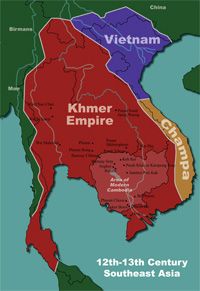
The Angkor city complex of temples and water systems at Angkor, were built by the very aggressive King Suryavarmam II. They were completed in 1145, and later abandoned to the jungle, when the Empire collapsed. But Angkor Wat, the city temple, was never abandoned. Since its rediscovery by Henri Mouhot, archaeologists have been excavating hundreds of temple ruins. Deep within the jungles of Siem Reap, Angkor was revealed for visitors to tour. Workers peeled away vines from palaces for us to explore. And they unearthed riches to be displayed in museums for posterity.
A big factor which led to the power of the Khmer rulers over their subjects was the concept of a king who was revered as a god. Because of this, their rule was autocratic and dogmatic. The kings were supported by learned Bhramins, scholars, teachers, and priests. Bhramins were believed to possess secret knowledge passed down from one generation to the next. This vital information on how to run an efficient empire was only passed on to the kings.
The Khmer Empire from the ninth to the fifteenth century emanated from its centre, the city of Angkor in Cambodia, or Kampuchea, its original name.
Khmer Temples in Thailand – Phanom Rung
The Southern strip of land along the Cambodian border runs from the towns of Buriram to Ubon Ratchatani. There you will find many Khmer temples in Thailand. The ruins stretch from there, up to the North, bordering Laos. Some of them date back to the 8th century. And it is a reminder of when much of Thailand was part of the powerful Khmer Empire.
The Hindu-Buddhist ruins, built by an advanced ancient civilisation, are truly magnificent. I visited several, including the ‘Phanom Rung’ National Park, 400m above sea level. It gave me an idea of what to expect when I later went to Angkor in Siem Reap, Cambodia.
Most of what is now North-East Thailand was part of the Khmer Empire. The ruins of the Hindu-Buddhist Khmer temples are dotted over the region, magnificent monuments built by an advanced ancient civilisation.
The History of Phanom Rung
Standing high on a hill, Phanom Rung was built from sandstone and laterite between the 10th and 13th centuries. It was a Hindhu shrine dedicated to the Hindhu god Shiva. The complex was restored between 1971 and 1988. Then it was offered for consideration as a future ‘World Heritage’ site to UNESCO in 2005. It was a moving experience, absorbing and imagining the engineering and architectural skills the ancient Khmers needed, to create the temple structures.
I was struck immediately by the scale of the huge building blocks hewn from stone. And not only how steep the steps all over the complex are but how deep. Anyone with short or ancient legs, like mine, really struggles to climb them, which was intentional.
‘Phanom Rung’ GPS co-ordinates: 14°31’57’N 102°56’30’E
Angkor and its Temples
Angkor, one of the most important archaeological sites in South-East Asia, covers 400 square kilometres of forest and swampland. It was the world’s largest urban conurbation prior to Britain’s 18th-century Industrial Revolution. Clearing the area alone would have been a mammoth task carried out by thousands of workers with primitive tools. Yet, amazingly, it took less than thirty-five years to build. It is easily accessible from where I lived, in Lam Plai Mat, near Buriram. I intended driving there but I never made the time to visit one of the wonders of the world. It meant I had to make the short plane trip from Phuket some years later.
In between times, I took solace from Jon Anderson. Relax and listen.
The Khmer’s famous legacy
Angkor is the Khmer empire famous legacy. A city which was bigger than many of today’s major cities. Angkor, the Khmer capital from the ninth to the fifteenth centuries, was the largest pre-industrial city in the world, with an urban sprawl of at least one thousand square kilometres.
It was abandoned in 1431AD, due to the civilisation’s decline from drought and invaders from Ayutthaya, North of Bangkok. Thai forces drove the Khmer inhabitants south in the fifteenth century, and they abandoned hundreds of temples as they retreated. The roads they built were used against them as rival empires came in and attacked just as the empire was about to fall.
Much has been written about the temples of Angkor and the construction of an incredible city. A city that flourished from its origin in the ninth to the fifteenth century and housed up to a million people at one point.
The Khmer Empire was far-reaching and much bigger than I realised before I studied its history and discovered remarkable things. They created a city that twenty-first century architects and planners would have been proud of, and its sophisticated water management system stored and dispensed water to support the burgeoning population.
Abandoning Angkor but not Angkor Wat
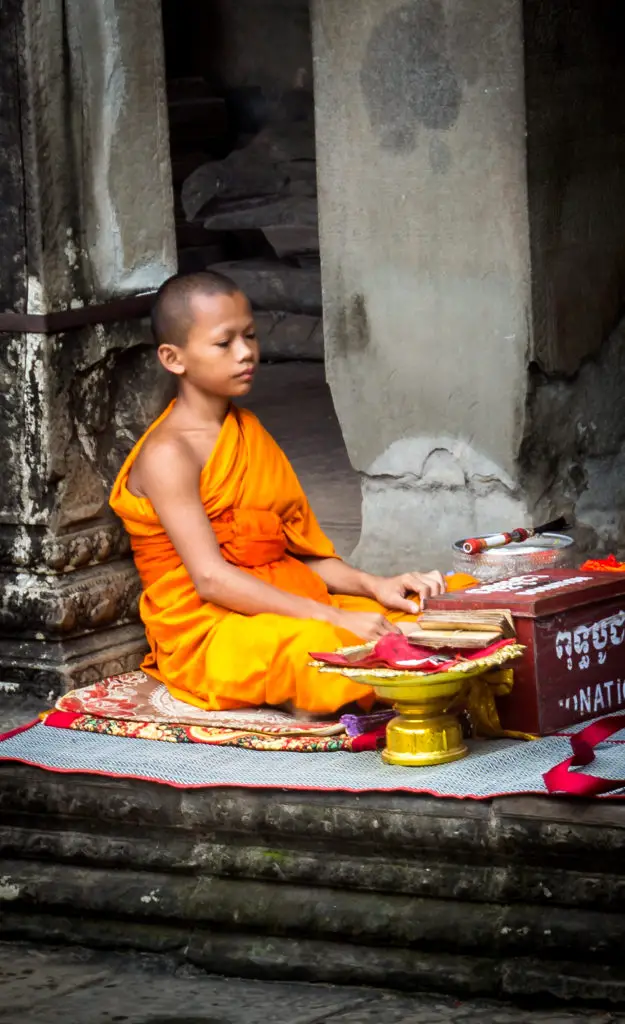
The Khmer completed the Angkor complex of temples and water systems in 1145, and it was later abandoned to the jungle, when the empire collapsed. But they never abandoned Angkor Wat.
Since Henri Mouhot discovered Angkor, four hundred years later, archaeologists have been excavating temple ruins deep within the jungle for visitors to tour. They have peeled away vines from palaces, exploring and unearthing artefacts from Cambodia’s past, to be displayed in museums. Their work may never be finished.
The archaeological site, extending over four hundred square kilometres, was the world’s largest urban conurbation before Britain’s 18th-century Industrial Revolution. Clearing the area was a mammoth task carried out by thousands of workers with primitive tools. Yet, it took less than thirty-five years to build.
Exploring one of the world’s great wonders
I was, about to explore a wonder of the world, flying into Siem Reap on a hot steamy morning to see firsthand the great Khmer empire legacy.
I did not expect to land in a clearing in the jungle, but it surprised me to find a state-of-the-art international airport. Small but impressive, it had the look of a five-star resort hotel and in a small way, was as twenty-first century as any I had seen.
A three-day pass gave me access to the whole UNESCO World Heritage Site of forty thousand hectares. They priced everything in US Dollars, even though Cambodia had its own currency, the Riel. I offered the lady at the ticket office, the dollar bills I had been advised to buy in Thailand before I left. But she refused to take them because they were dirty. Strange as it seemed, she was happy to take my Thai Baht notes which were just as dirty.
Cambodia was colonised by the French, so it surprised me how good the Cambodians English was.
My Guide and his Remork
I hired an articulate and charming remork driver, to look after me for three days. He drove from his home for an hour on the first morning to be with me by five am, so I could see Angkor Wat at sunrise. We bumbled along the rugged roads, through rice fields and forests.
A remork is Cambodia’s equivalent of a tuk-tuk, only more comfortable and less noisy; a two-wheeled carriage drawn by a motorbike instead of a horse. My guide supported a wife and two children, and had been a remork driver for ten years. He ferried an increasing number of tourists every year from the airport and Siem Reap town to Angkor. And he stayed with them all day, taking them from wat to wat around the park.
Angkor Wat at dawn is an awe inspiring sight
As we got closer to the centre of Angkor, I wondered how I would feel when I first saw Angkor Wat. Would it be as I imagined, a breath-taking, moving sight. We trundled along the dusty roads, trusting in the dim headlight of the motorbike that powered Pisey’s remork, and it was still dark when we parked.
Then, as I left, I felt a chill and a tingling sensation, as dawn broke behind the wat and it came into view for the first time. It stood in magnificent silhouette, even more imposing than I imagined. And though I was itching to walk across the bridge over the lake and through the temple gate, I couldn’t move. I fumbled with my camera, almost in a panic, in case I missed capturing images of the wat. Then it emerged, out of the night, a black silhouette in the distance, backlit by the dim but steadily growing light from the morning sun. A spectacular sight.
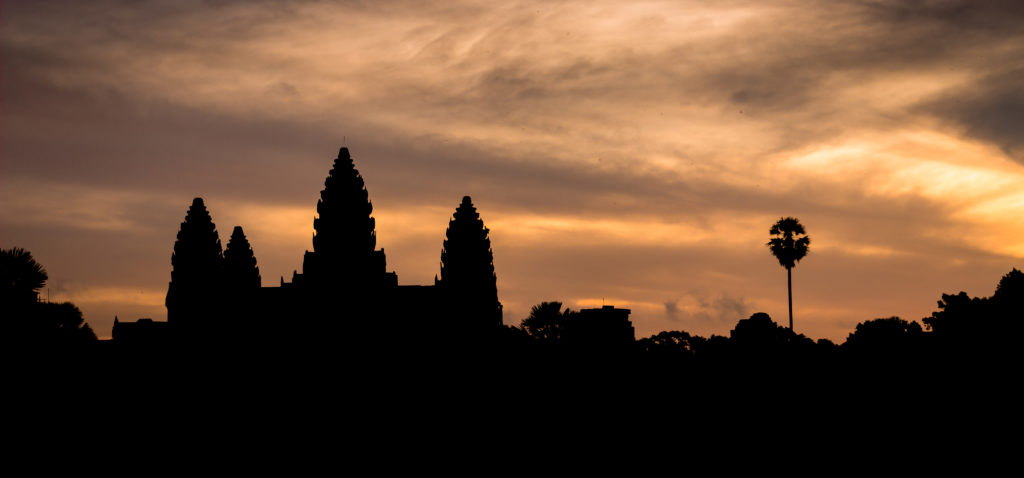
A stampede of photographers
Hundreds, maybe thousands of visitors swarmed across the moat and through the three gates leading into the grounds of the wat. Most people gravitated towards the pond on the right, to see the sun rise behind the spectacular edifice.
The sun’s appearance changed with the seasons, so positioning needed to be different depending on the time of year. To avoid the crowd on the right, I went to the far left and found a secluded spot under a massive tree overlooking the other pond. It was perfect, and I set my camera on its tripod, waiting for the sun to introduce the day.
More of Angkor’s monuments
The temperature rose higher in concert with the sun as we approached Ta Phrom. Tomb Raiders made millions at the Box Office and I was sure Ta Phrom, which provided the backdrop, attracted millions of visitors as a result. Much smaller than Angkor Wat, it was captivating, and I could easily have believed it grew out of the jungle, and was a part of the trees, vines and creepers that bound the crumbling ruins together. I could see why they chose it for the film, as it was still derelict and far from restored.
Preah Khan – My favourite temple
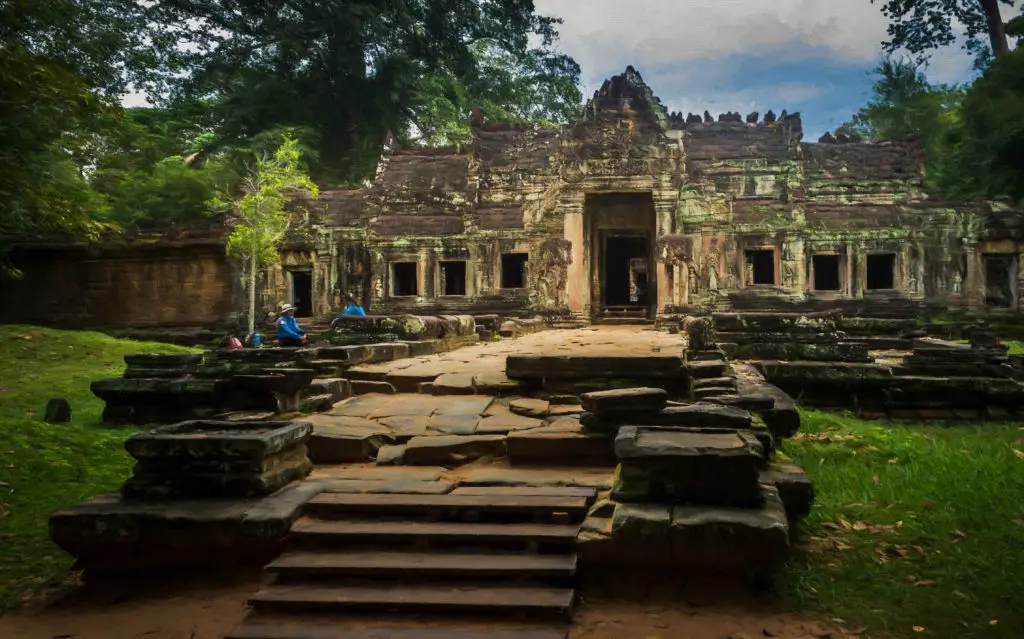
If I had to choose one temple to visit, it would be Preah Khan. Larger than Ta Phrom, it had the same feeling of having grown out of the jungle, an integral part of nature.
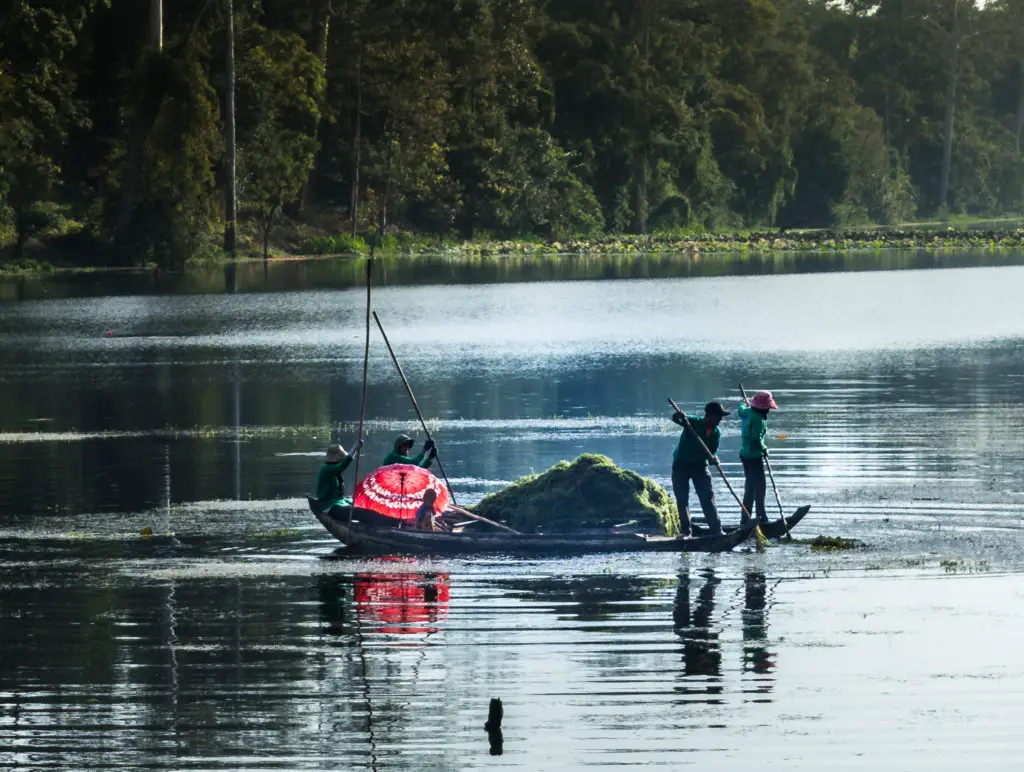
I spent a long time outside before I went through the entrance gate because I was so taken by the bridge, the boat fishermen, and the stunning forest that enveloped the outside of the wall. I could have spent a week at Preah Khan alone and would have been satisfied with my trip.
But I could not make it through the endless labyrinth of alleyways and courtyards, though I tried; there were just too many, and I was exhausted from the heat. I rested several times, sitting on the precision cut giant stone blocks, that required no mortar to stablilise the structure.

I took on water, and the cool interior of the building revived me, as I moved slowly, passage by passage through the maze. Opening after opening marked each section. What was the purpose of such a structure?
Preah Khan was once a Bhuddist monastery, a university, a fairground with hundreds of dancers, a palace, and an entire city of one hundred thousand people. Now it was the ruins of an ancient one-stop mall.
From Hinduism to Buddhism
The conversion of the Khmer Empire from Hindu to Mahayana Buddhism could well have influenced the decline of Angkor, by eroding the workforce necessary to maintain the temples. Angkor Wat, which was the largest temple, became a Buddhist shrine that was cared for by Theravada monks until the 17th century, after which it was engulfed by the jungle and not seen for two hundred years. In 1860 Angkor was shown to Henri Mouhot.
The French began surveys and inventories in 1898 when France was a protectorate of Cambodia. Archaeological work began in 1908 following the establishment of Angkor Conservation in Siem Reap. There was so much work still to be done, I couldn’t imagine it ever stopping.
Hundreds of temples, in varying condition, lie within the area of Angkor which was visited by two million tourists each year. The number of people presented an enormous challenge to the maintenance, preservation, and restoration teams. Cambodia is a poor country which has relied on tourism, and when I visited in 2017, there was a conflict of interest between conservationists and the much-needed revenue from visitors. Many areas should have been protected from the foot traffic, which eroded the sandstone monuments. But the danger was they had left it too late.
Final thoughts
I wondered if it was the first and last time, I would see the defiant grandeur of Angkor Wat, as we drove out of the park on my last day. Whatever transpires, the Khmer empire achievements must stand alongside those of the great empires, and like the empires before they have left much for us to ponder.


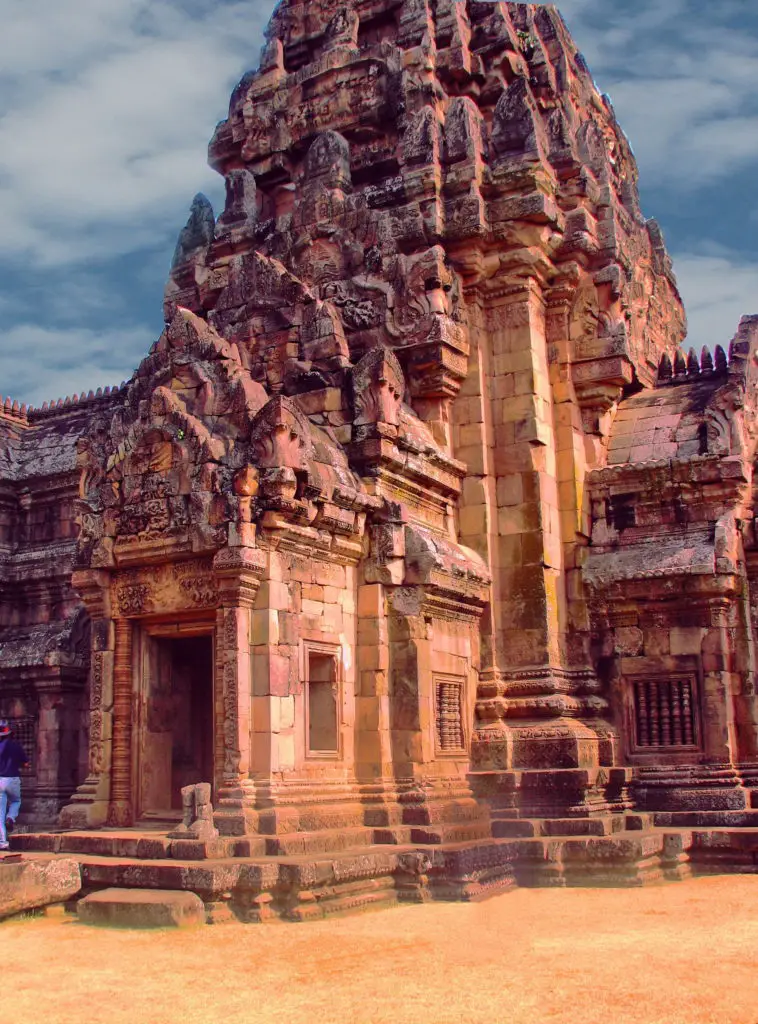
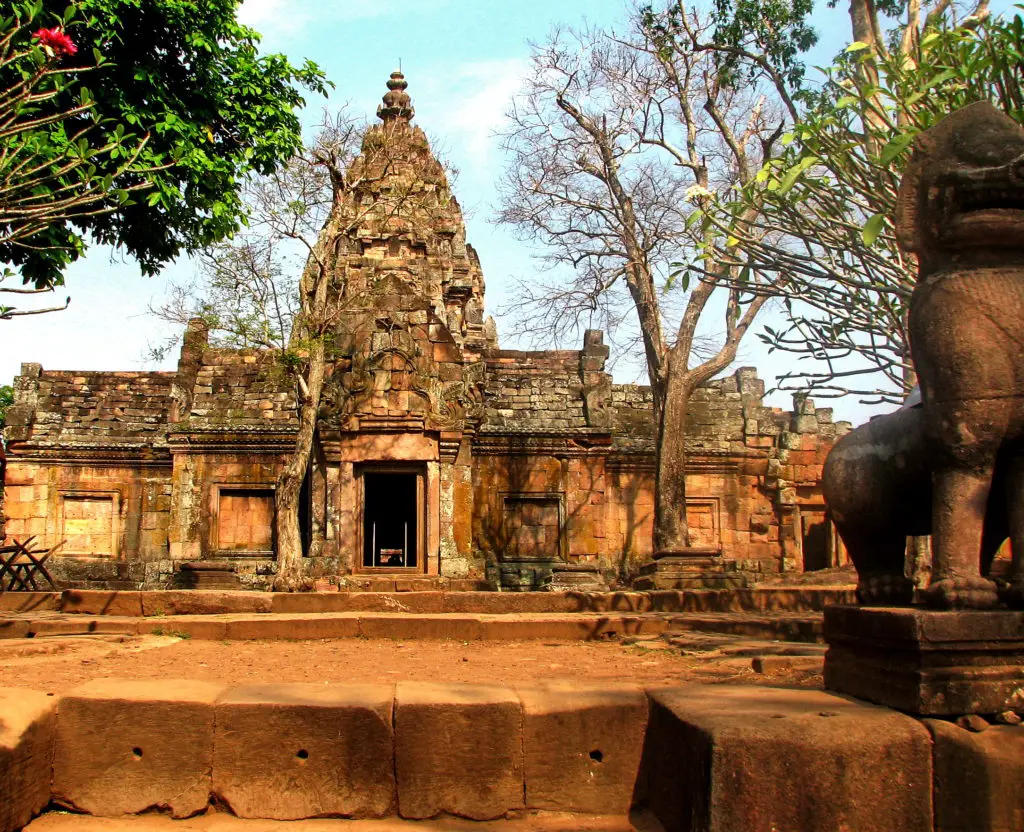
very good